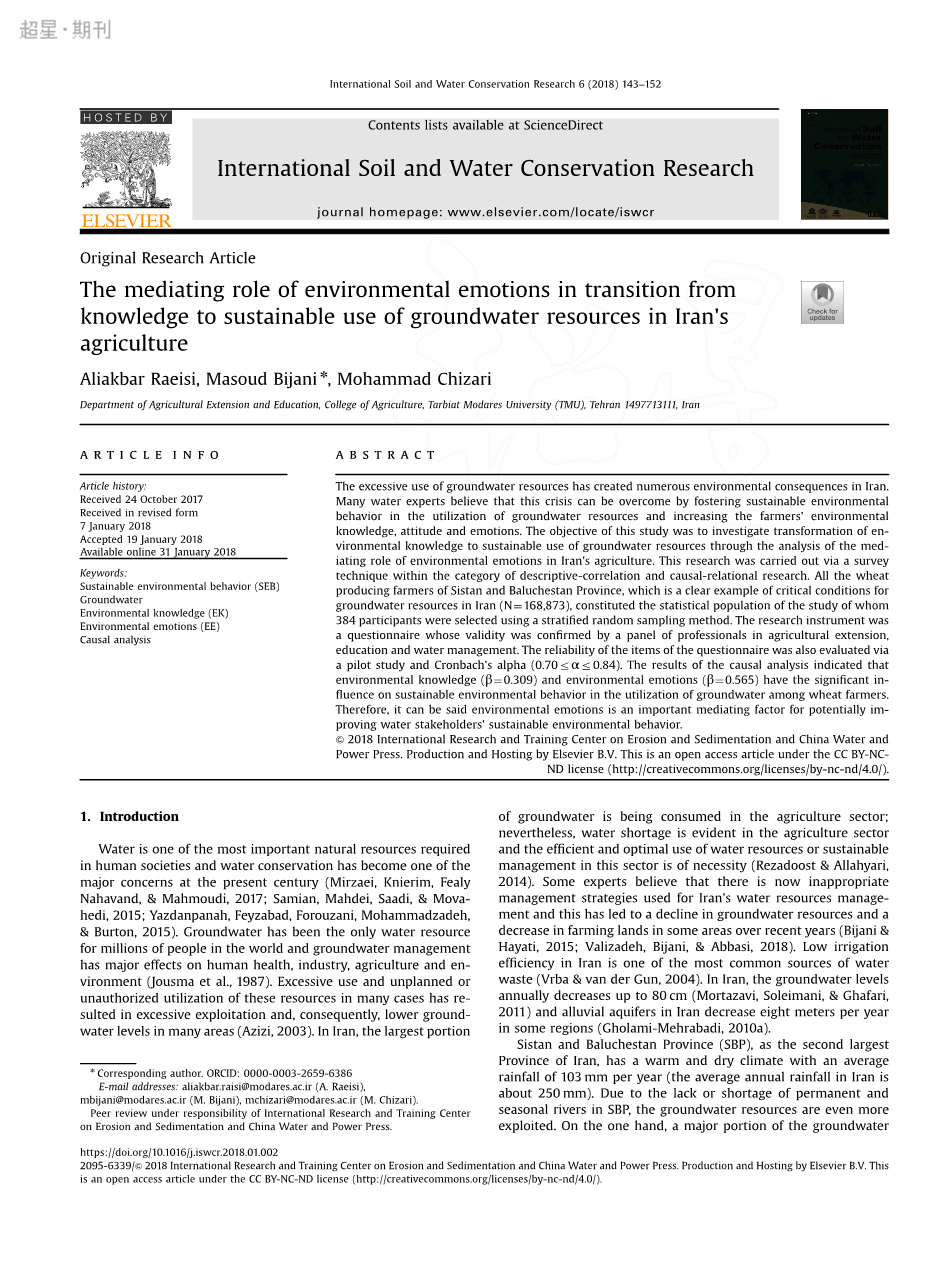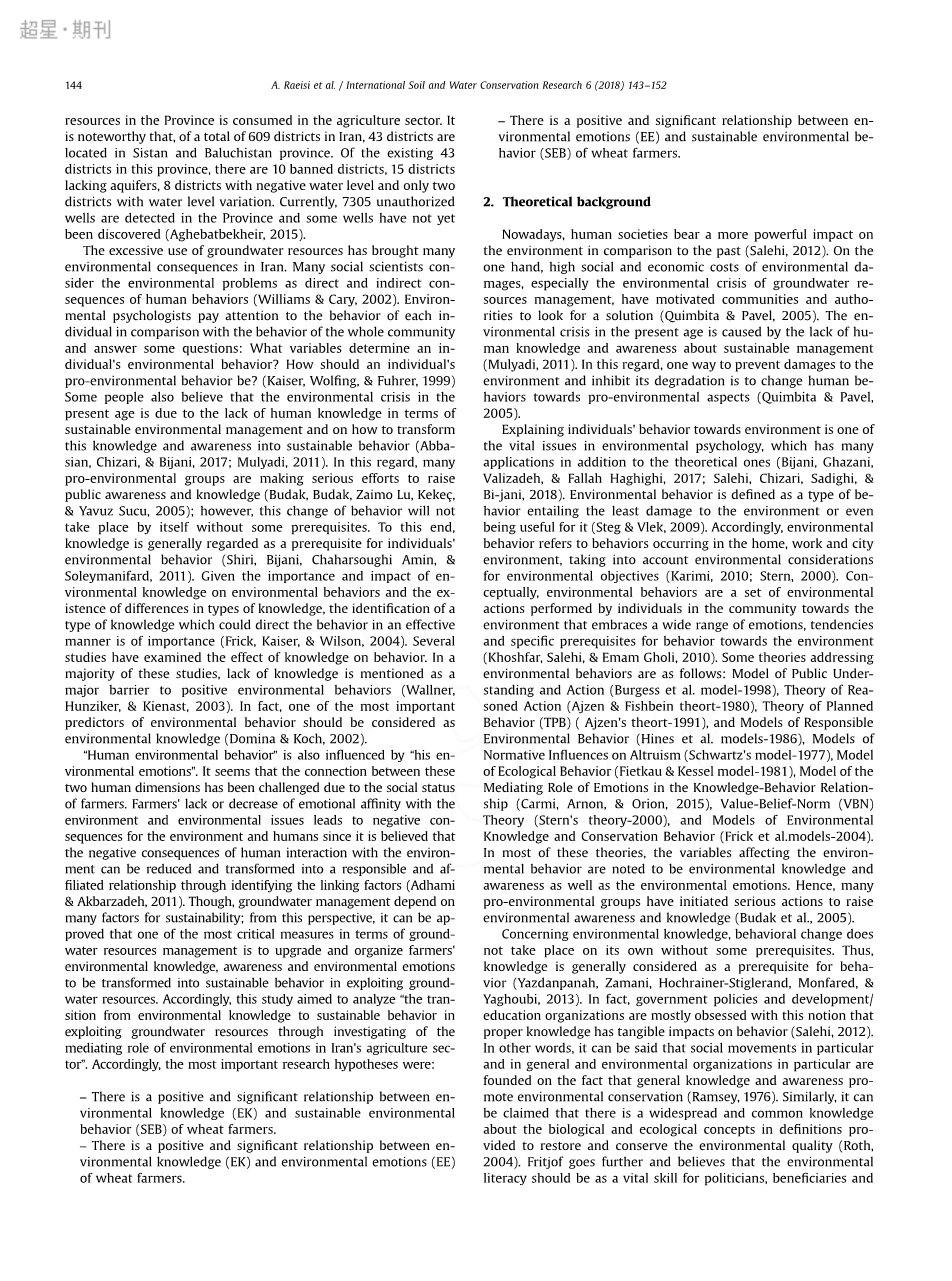

英语原文共 9 页,剩余内容已隐藏,支付完成后下载完整资料
The mediating role of environmental emotions in transition from knowledge to sustainable use of groundwater resources in Iran#39;s agriculture
环境情绪在伊朗农业地下水资源从知识向可持续利用过渡过程中的中介作用
Keywords:Sustainable environmental behavior (SEB) Groundwater Environmental knowledge (EK) Environmental emotions (EE)
Causal analysis
关键词: 可持续环境行为 (SEB) 地下水环境知识 (EK) 环境情绪 (EE) 原因分析
The excessive use of groundwater resources has created numerous environmental consequences in Iran. Many water experts believe that this crisis can be overcome by fostering sustainable environmental behavior in the utilization of groundwater resources and increasing the farmers#39; environmental knowledge, attitude and emotions. The objective of this study was to investigate transformation of environmental knowledge to sustainable use of groundwater resources through the analysis of the mediating role of environmental emotions in Iran#39;s agriculture. This research was carried out via a survey technique within the category of descriptive-correlation and causal-relational research. All the wheat producing farmers of Sistan and Baluchestan Province, which is a clear example of critical conditions for groundwater resources in Iran (N=168,873), constituted the statistical population of the study of whom 384 participants were selected using a stratified random sampling method. The research instrument was a questionnaire whose validity was confirmed by a panel of professionals in agricultural extension, education and water management. The reliability of the items of the questionnaire was also evaluated via a pilot study and Cronbach#39;s alpha (0.70le;alpha;le;0.84). The results of the causal analysis indicated that environmental knowledge (beta;=0.309) and environmental emotions (beta;=0.565) have the significant influence on sustainable environmental behavior in the utilization of groundwater among wheat farmers. Therefore, it can be said environmental emotions is an important mediating factor for potentially improving water stakeholders#39; sustainable environmental behavior.
过度使用地下水资源在伊朗造成了许多环境后果。许多水专家认为, 通过促进地下水资源利用方面的可持续环境行为, 增加农民的环境知识、态度和情绪, 可以克服这场危机。本研究的目的是通过分析环境情绪在伊朗农业中的中介作用, 调查环境知识向地下水资源可持续利用的转变。本研究是通过描述相关性和因果关系研究范畴内的一种调查技术进行的。锡斯坦省和俾路支斯坦省的所有小麦生产农民都是伊朗地下水资源危急状况的一个明显例子 (Ncis 168. 873), 这些农民是研究的统计群体, 有384名参与者是通过分层随机抽样方法。研究工具是一份调查问卷, 其有效性得到了农业推广、教育和水管理专业人员小组的确认。通过试点研究和克朗巴赫的alpha; (0.70le;alpha;le;0.84), 对问卷项目的可靠性进行了评价。因果分析结果表明, 环境知识 (beta;= 0.309) 和环境情绪 (beta;= 0.309) 对小麦农民地下水利用的可持续环境行为有显著影响。因此, 可以说, 环境情绪是潜在改善水利益相关者可持续环境行为的重要中介因素。
1. Introduction
Water is one of the most important natural resources required in human societies and water conservation has become one of the major concerns at the present century (Mirzaei, Knierim, Fealy Nahavand, amp; Mahmoudi, 2017; Samian, Mahdei, Saadi, amp; Mova-hedi, 2015; Yazdanpanah, Feyzabad, Forouzani, Mohammadzadeh, amp; Burton, 2015). Groundwater has been the only water resource for millions of people in the world and groundwater management has major effects on human health, industry, agriculture and environment (Jousma et al., 1987). Excessive use and unplanned or unauthorized utilization of these resources in many cases has resulted in excessive exploitation and, consequently, lower groundwater levels in many areas (Azizi, 2003). In Iran, the largest portion
of groundwater is being consumed in the agriculture sector; nevertheless, water shortage is evident in the agriculture sector and the efficient and optimal use of water resources or sustainable management in this sector is of necessity (Rezadoost amp; Allahyari, 2014). Some experts believe that there is now inappropriate management strategies used for Iran#39;s water resources management and this has led to a decline in groundwater resources and a decrease in farming lands in some areas over recent years (Bijani amp; Hayati, 2015; Valizadeh, Bijani, amp; Abbasi, 2018). Low irrigation efficiency in Iran is one of the most common sources of water waste (Vrba amp; van der Gun, 2004). In Iran, the groundwater levels annually decreases up to 80 cm (Mortazavi, Soleimani, amp; Ghafari, 2011) and alluvial aquifers in Iran decrease eight meters per year in some regions (Gholami-Mehrabadi, 2010a).
Sistan and Baluchestan Province (SBP), as the second largest Province of Iran, has a warm and dry climate with an average rainfall of 103mm per year (the average annual rainfall in Iran is about 250mm). Due to the lack or shortage of permanent and seasonal rivers in SBP, the groundwater resources are even more exploited. On the one hand, a major portion of the groundwater
水是人类社会所需的最重要的自然资源之一, 节约用水已成为本世纪的主要关切之一 (Mirzaei、Knierim、Fealy Nahavand、amp; Mahmoudi, 2017;Samian, Mahdei, Saadi, amp; Mova-hedi, 2015;Yazdanpanah, Feyzabad, Forouzani, Mohammadzadeh, amp; Burton, 2015年)。地下水一直是世界上数百万人唯一的水资源, 地下水管理对人类健康、工业、农业和环境产生重大影响 (Jousma 等人, 1987年)。在许多情况下, 过度使用这些资源以及无计划或未经授权地利用这些资源导致过度开采, 从而降低了许多地区的地下水位 (Azizi, 2003年)。在伊朗, 农业部门消耗的地下水占地下水的最大部分;然而, 农业部门的缺水现象十分明显, 该部门必须有效和最佳地利用水资源或可持续管理 (Rezadoost amp; Allahyari, 2014年)。一些专家认为, 现在伊朗水资源管理采用了不适当的管理战略, 这导致近年来地下水资源减少, 一些地区的农田减少 (Bijani amp; Hayati, 2015;瓦里扎德, Bijani amp; Abbasi, 2018年)。伊朗灌溉效率低是最常见的水污染源之一 (Vrba amp; van der Gun, 2004年)。在伊朗, 地下水位每年下降高达80厘米 (Mortazavi, Soleimani, amp; Ghafari, 2011年), 伊朗的冲积含水层在一些地区每年减少8米 (Gholami-me打马迪, 2010a)。 锡斯坦和俾路支斯坦省 (SBP) 作为伊朗第二大省, 气候温暖干燥, 年平均降雨量为103毫米 (伊朗年平均降雨量约为250毫米)。由于 SBP 缺乏或缺乏永久和季节性河流, 地下水资源得到了更多的开发。一方面, 地下水的很大一部分.
图2
3. Research methodology 3.1. Research design
Research studies use one or more methods to achieve their objectives. This research is quantitative in terms of its nature, non-experimental in terms of controlling variables and applied regarding the research objectives since its findings have some implications for planners and managers involved in the groundwater resources management. Concerning the data collection method, the present study was a survey and the concerned study design was descriptive-correlational and causal-re
全文共15828字,剩余内容已隐藏,支付完成后下载完整资料
资料编号:[1389]
以上是毕业论文外文翻译,课题毕业论文、任务书、文献综述、开题报告、程序设计、图纸设计等资料可联系客服协助查找。


